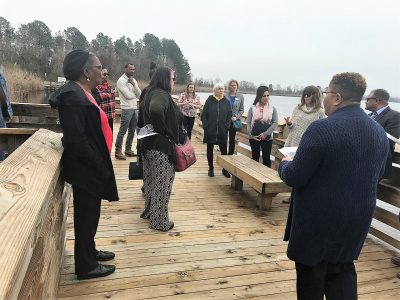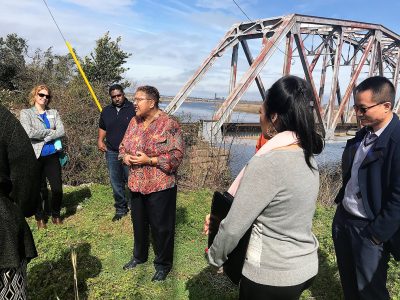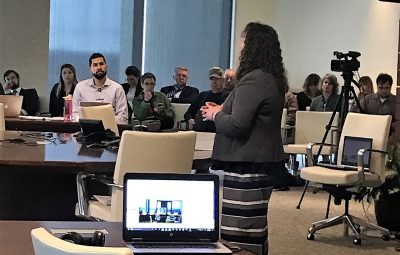
This story was co-published in partnership with North Carolina Health News
Members of a new state panel boarded a church bus Tuesday morning in Wilmington, intent on exploring the environmental atrocities of the past and determined to keep history from repeating itself.
Supporter Spotlight
Veronica Carter stood at the front of the bus, serving as a guide on a roughly 25-mile, three-hour tour for the 16-member North Carolina Department of Environmental Quality’s Environmental Justice and Equity Advisory Board.
The board’s primary objective is to protect and provide a voice for people living in underserved and underrepresented communities across the state — communities that are, by and large, poor and black.
Perhaps nowhere else in the state are the reminders of past environmental disasters in these communities more vivid or as shameful as they are near Wilmington.
Shortly after the bus rolled out, Carter, a retired Army major and a board member, called attention to Wilmington’s 1898 Memorial Park, which commemorates blacks who died or were run out of town in November of that year when a white mob overthrew Wilmington’s biracial government.
Supporter Spotlight
“African Americans in this city have never recovered,” Carter bellowed in her Army voice before the bus turned onto a paved road lined by trailers and small houses, some still bearing blue tarps and other scars left nearly six months ago by the winds and record-setting rain of Hurricane Florence.
This is the Flemington community, Carter told the group, referring to the poor, largely black community off U.S. 421 in New Hanover County that had unknowingly been drinking well water laced with arsenic, boron, cobalt and other contaminants for decades.
The toxins came from an unlined pit where Duke Energy had stored coal ash, the residue of a coal-fired power plant that operated here from 1954 until 2013, when Duke opened a $600 million natural gas plant nearby.
Duke was fined a record $25.1 million for the contamination, a figure that was later reduced to $7 million in a settlement with the state. Duke also paid more than $3 million to have public water lines run to the Flemington community in 2016. None of the money, Carter told the group, went to pay medical bills for residents who may have been harmed by the contamination.
“These small communities never have a chance,” said Carter, an environmental activist and board member with the North Carolina Coastal Federation.
Duke is now excavating the coal ash and putting it in nearby lined pits that will be capped when the work is complete. A deadline for completion has been set for later this year.
Sutton Lake
Sutton Lake sits a stone’s throw from the Flemington community. The 1,100-acre reservoir was formed by Duke’s predecessor, Carolina Power & Light, in 1972 to cool its power plant.

An earthen dam at the lake breached during Hurricane Florence, flooding coal ash pits and spilling some of their toxic contents into the Cape Fear River. State regulators say the spill did not harm the river.
Environmentalists say Sutton Lake is contaminated, too, an opinion backed by science but one that remains up for debate.
A study in 2017 by Duke University found high levels of selenium in fish in Sutton and two other North Carolina lakes that had been receiving coal ash from power plants.
According to the study, early life exposure to selenium can cause deformities, impaired growth and reproduction, and in extreme cases death in fish and aquatic invertebrates. Because selenium accumulates in the food chain, it also can be toxic to birds that eat aquatic animals containing high levels.
Of the three lakes studied, Sutton had the highest concentration of selenium, with 85 percent of all fish muscle samples containing levels above what the U.S. Environmental Protection Agency considers safe.
Board members departed the bus at Sutton Lake’s public access area, where Carter said a dock is usually thronged by people fishing, not for recreation but for subsistence. For many, Carter told the group, fish from the lake is their primary source of protein.
Some board members asked why there are no signs at the dock or the public boat ramp warning people that the fish may be contaminated.
It’s an old story, responded Dana Sargent, deputy director of Cape Fear River Watch. No one — not the state or local governments — knows who would be responsible for placing the signs.
Contamination in Navassa
Board members asked question after question as the bus headed to its next destination, the town of Navassa, where the majority of its 1,895 residents are black and poor. Many are the descendants of the Gullah Geechee people, who arrived here to work in the town’s rice plantations.
The bus stopped outside Reaves Chapel, a dilapidated clapboard church built after the Civil War that once served as a house of worship for the Gullah Geechee.

Efforts are underway to restore the church, which sits in a woods that are about to give way to two new subdivisions containing 6,000 homes — three times as many homes as Navassa now has people. Board members remarked that the subdivisions could lead to more problems for the Navassa natives, including gentrification, higher property values and a dilution of voting strength.
It’s the cumulative effects of environmental contamination that Carter and other board members worry about most. Navassa is a poster town for those impacts. The town has four inactive brownfield sites, land that cannot be developed because of industrial contamination lying under the surface. Carter told the group that there are more brownfield and federal Superfund sites in Navassa than any other municipality in the state.
The bus rolled past some of the brownfield sites before arriving at the former Kerr-McGee Chemical Corp. plant, which used to preserve wood with creosote in unlined pits from 1936 to 1974. The creosote, a probable carcinogen, has seeped as deep as 100 feet into the ground, Carter told the group.
The EPA deemed the property a Superfund site and added it to its National Priorities List in 2010. Efforts are now underway to turn some of the land into public space, which could include a park with trails and an amphitheater, a river walk and a rice field for demonstration purposes of the town’s heritage. The remainder of the land remains unuseable.
Carter, who lives in the neighboring town of Leland, said she has heard from many people living in Navassa whose relatives had died at an early age from cancer. Although there is no way to quantify whether contaminants caused the diseases, Carter said, “you know we think in our heart of hearts that was the problem.”
Board Urged to Act
The bus arrived back at Cape Fear Community College about 1 p.m. The tour served as a prelude to the board’s third meeting since it was formed last May.

After concluding the mundane matters of a new board, including the names of subcommittees, the panel heard from two of the DEQ’s top-ranking officials, Sheila Holman, assistant secretary for the environment, and John Nicholson, DEQ’s chief deputy secretary.
Holman unveiled a new mapping tool, which she and other DEQ officials said will enable local planners to better determine the suitability of proposed industrial sites and inform residents of the potential environmental effects those industries could cause. The tool is expected to become available for public use April 1.
The board also approved statements about their concerns over coal ash and industrial-scale animal farms. The statements will be provided to DEQ officials.
But perhaps the most telling part of the board’s mission came during the public comments period at its conclusion. About a dozen speakers stood up, most praising the board for its work and expressing deep concerns about GenX or coal ash.
Frank Holleman, senior attorney with the Southern Environmental Law Center’s Chapel Hill office, urged the board to voice objection to Duke Energy’s plans to excavate coal ash pits from only eight of its 14 coal-fueled power plants. Many of those plants have converted to natural gas.
Holleman noted that South Carolina and Virginia have required energy companies in those states to remove the coal ash and place it in lined and covered landfills. North Carolina needs to do the same, he said.
“This is an opportunity for the state and the governor of this state to do something about it,” Holleman said, urging the board to speak up. “There is no better body to take action than this body.”
The Rev. Gregory Hairston told the board that people are becoming ill from the 12 million tons of coal ash stored in Stokes County, where he lives.
“I try to encourage you because we feel we are not getting a fair shake,” Hairston said. “It’s time that we had a voice, and we feel that we don’t have a voice in our state … We demand and we request that you be a forceful voice for us.”
Board Hears Complaints, Too
The board also heard complaints from residents.
“You’re understaffed, you’re under budget, I get it,” said Ashley Daniels, a member of Cape Fear River Watch and the North Carolina Environmental Justice Network. “But if you are saying you want to include the community, you have to do better.”
Daniels complained that there is too little notice of board meetings, and too little time to prepare for them. Carter agreed. She asked that the next meeting, set for this summer, be held later in the day so more people could attend.
John Wagner of Chatham County complained that the board “is moving too slow.”
“I know you all have lives, but you are the board,” Wagner said. “Our house is on fire.”
Leslie Cohen said that, as a candidate for a state House seat last year, she spoke to thousands of people whose No. 1 concern is contamination of their drinking water. Many people cannot afford to buy bottled water or filtration systems, she said.
“We need you,” Cohen told the board. “Every citizen of North Carolina needs you.”








